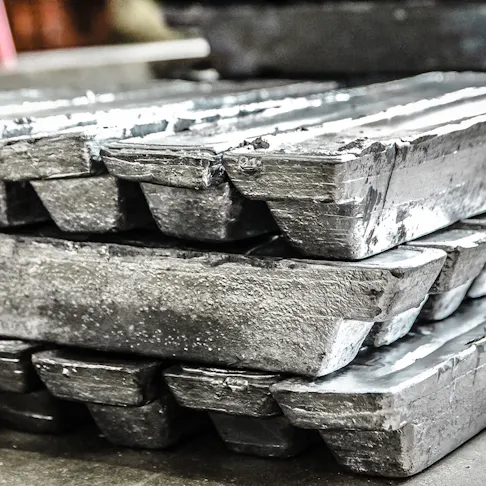Math Is Fun Forum
You are not logged in.
- Topics: Active | Unanswered
- Index
- » Science HQ
- » Lead
Pages: 1
#1 2024-05-19 18:17:33
- Jai Ganesh
- Administrator

- Registered: 2005-06-28
- Posts: 52,736
Lead
Lead
Gist
Lead is a chemical element; it has symbol Pb (from Latin plumbum) and atomic number 82. It is a heavy metal that is denser than most common materials. Lead is soft and malleable, and also has a relatively low melting point. When freshly cut, lead is a shiny gray with a hint of blue.
Details
Lead is a chemical element; it has symbol Pb (from Latin plumbum) and atomic number 82. It is a heavy metal that is denser than most common materials. Lead is soft and malleable, and also has a relatively low melting point. When freshly cut, lead is a shiny gray with a hint of blue. It tarnishes to a dull gray color when exposed to air. Lead has the highest atomic number of any stable element and three of its isotopes are endpoints of major nuclear decay chains of heavier elements.
Lead is a relatively unreactive post-transition metal. Its weak metallic character is illustrated by its amphoteric nature; lead and lead oxides react with acids and bases, and it tends to form covalent bonds. Compounds of lead are usually found in the +2 oxidation state rather than the +4 state common with lighter members of the carbon group. Exceptions are mostly limited to organolead compounds. Like the lighter members of the group, lead tends to bond with itself; it can form chains and polyhedral structures.
Since lead is easily extracted from its ores, prehistoric people in the Near East were aware of it. Galena is a principal ore of lead which often bears silver. Interest in silver helped initiate widespread extraction and use of lead in ancient Rome. Lead production declined after the fall of Rome and did not reach comparable levels until the Industrial Revolution. Lead played a crucial role in the development of the printing press, as movable type could be relatively easily cast from lead alloys. In 2014, the annual global production of lead was about ten million tonnes, over half of which was from recycling. Lead's high density, low melting point, ductility and relative inertness to oxidation make it useful. These properties, combined with its relative abundance and low cost, resulted in its extensive use in construction, plumbing, batteries, bullets and shot, weights, solders, pewters, fusible alloys, white paints, leaded gasoline, and radiation shielding.
Lead is a neurotoxin that accumulates in soft tissues and bones. It damages the nervous system and interferes with the function of biological enzymes, causing neurological disorders ranging from behavioral problems to brain damage, and also affects general health, cardiovascular, and renal systems. Lead's toxicity was first documented by ancient Greek and Roman writers, who noted some of the symptoms of lead poisoning, but became widely recognized in Europe in the late 19th century.
Physical properties
Atomic
A lead atom has 82 electrons. The sum of lead's first and second ionization energies—the total energy required to remove the two 6p electrons—is close to that of tin, lead's upper neighbor in the carbon group. This is unusual; ionization energies generally fall going down a group, as an element's outer electrons become more distant from the nucleus, and more shielded by smaller orbitals.
The sum of the first four ionization energies of lead exceeds that of tin, contrary to what periodic trends would predict. This is explained by relativistic effects, which become significant in heavier atoms, which contract s and p orbitals such that lead's 6s electrons have larger binding energies than its 5s electrons. A consequence is the so-called inert pair effect: the 6s electrons of lead become reluctant to participate in bonding, stabilising the +2 oxidation state and making the distance between nearest atoms in crystalline lead unusually long.
Lead's lighter carbon group congeners form stable or metastable allotropes with the tetrahedrally coordinated and covalently bonded diamond cubic structure. The energy levels of their outer s- and p-orbitals are close enough to allow mixing into four hybrid sp3 orbitals. In lead, the inert pair effect increases the separation between its s- and p-orbitals, and the gap cannot be overcome by the energy that would be released by extra bonds following hybridization. Rather than having a diamond cubic structure, lead forms metallic bonds in which only the p-electrons are delocalized and shared between the Pb2+ ions. Lead consequently has a face-centered cubic structure like the similarly sized divalent metals calcium and strontium.
Bulk
Pure lead has a bright, shiny gray appearance with a hint of blue. It tarnishes on contact with moist air and takes on a dull appearance, the hue of which depends on the prevailing conditions. Characteristic properties of lead include high density, malleability, ductility, and high resistance to corrosion due to passivation.
Lead's close-packed face-centered cubic structure and high atomic weight result in a density of 11.34 g/{cm}^3, which is greater than that of common metals such as iron (7.87 g/{cm}^3), copper (8.93 g/{cm}^3), and zinc (7.14 g/{cm}^3). This density is the origin of the idiom to go over like a lead balloon. Some rarer metals are denser: tungsten and gold are both at 19.3 g/{cm}^3, and osmium—the densest metal known—has a density of 22.59 g/{cm}^3, almost twice that of lead.

It appears to me that if one wants to make progress in mathematics, one should study the masters and not the pupils. - Niels Henrik Abel.
Nothing is better than reading and gaining more and more knowledge - Stephen William Hawking.
Offline
Pages: 1
- Index
- » Science HQ
- » Lead